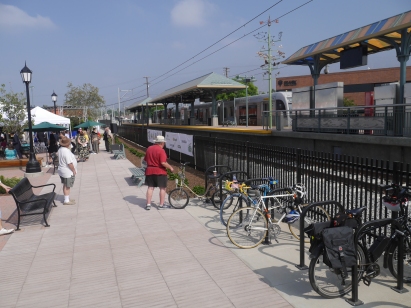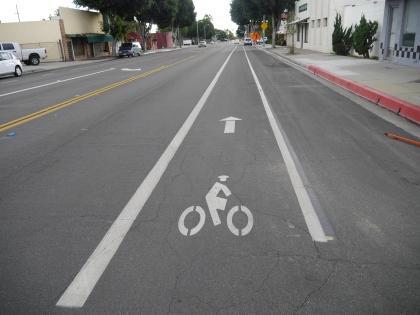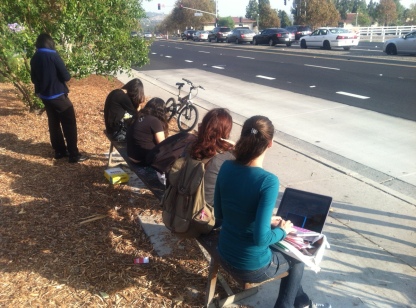2016 Highlights
As 2016 comes to a close, it’s time for taking stock of the year’s developments in car-free transportation in the San Gabriel Valley.
At the top of my list is the opening of the Gold Line extension from Pasadena to Azusa. This brought the Gold Line closer to my house, and allows me to take the train for part of my commute to work at Cal Poly Pomona. The rest of the trip is on Foothill Transit‘s extensive bus service in the east San Gabriel Valley. The Foothill Transit 280 and 486 buses run every 15 minutes during peak times, and their new buses are quite comfortable. The new commute cuts about 15 minutes off my old route through El Monte Bus Station and allows me to bypass the infrequent service of the Metro 487 bus line. The bike portion of my new commute is also shorter, which makes it more manageable on a regular basis. The easy bike ride to/from the Gold Line now allows me to get around car-free much more easily. I’ve been heartened by the ridership I’ve seen–including many more people doing multimodal bike-transit commuting east of Pasadena.
New bus shelters at Cal Poly Pomona. For too long, Cal Poly’s bus stops on Temple Ave. provided no shelter and little more than a splintered old bench for bus riders (see pictures). As a result of student activism and new campus leadership, there are two new bus shelters at the main campus bus stops on Temple Ave. This is certainly a step in the right direction and I’m modestly hopeful for additional progress on transit and bike access to campus.
Thanks to the work of many local advocates, progress toward new bike plans have been made in Pasadena, Monrovia, and La Verne. With better infrastructure, I’m confident we’ll see an uptick in bike ridership, which in turn should lead to even more bike infrastructure in the future. Despite these small victories, the pace of change in the SGV is so slow and incremental that it barely registers today. Too many streets are unsafe for cycling and too many destinations are hard to get to by bike and when you arrive, they often lack basic bike amenities like bike racks. It’s easy to feel angry about the lack of good bike infrastructure that places people at risk and deters others from riding in the SGV, but there are good people working to change this, and they must be given due credit. The advocates at BikeSGV, for example, have done some wonderful work organizing community rides, setting up the Bike Education Center in El Monte, advocating for complete streets, and bringing a multi-city open streets event to the SGV. They honored me this past year with an award for my bike advocacy, an award for which I was hardly worthy, but profoundly honored, nonetheless. I draw hope and inspiration from these fellow advocates.
Education and outreach. In 2016 I was involved in an alternative transportation project at my daughter’s high school and an alternative transportation conference at Cal Poly Pomona. I also was privileged to speak on “cycling and social justice” to a group of inmates in a Prison Education Project at the invitation of one of my fantastic colleagues at Cal Poly, political science professor Dr. Renford Reese. In general, I found many of the people I spoke to open to the message of bicycling, walking, and transit for healthier communities. Spreading the message of the many benefits of car-free alternatives was deeply gratifying.

Scott Schultz of BUSted Los Angeles speaks to students at Cal Poly’s alternative transportation conference in November.
Measure M. The half-cent sales tax for transportation passed in Los Angeles by a healthy margin (approx. 70 percent voted yes). This will mean expansion of Metro rail, local bus service, and bike and pedestrian infrastructure. Measure A, a countywide tax for parks, also passed, which means LA County will have funds for turning many of its now-barren flood control channels into “linear parks” with multi-use paths. Such victories give me hope.
Notable Books and Films of 2016:
- Frackopoly: The Battle for the Future of Energy and the Environment by Winona Hauter. Essential reading for anyone who wants to understand why hydraulic fracturing (“fracking”) of oil and natural gas is neither safe nor a “bridge fuel” to sustainable energy.
- Routes of Power: Energy and Modern America by Christopher F. Jones. Technically, came out last year, but it was new to me this year, so I’m including it here. Jones, an historian at Arizona State University, weaves a fascinating story of how the infrastructure of fossil fuel was created in the United States, and offers a deeper understanding of how energy transitions take place–essential knowledge as we transition away from a carbon economy. His research also underscores the central importance of pipelines for the delivery of fossil fuel and the expansion of the carbon economy, and thus the importance of blocking the construction of new pipelines in the fight for a livable climate and clean water.
- Street Fight: Handbook for an Urban Revolution by Janette Sadik-Khan. The lively story of how Sadik-Khan, former transportation commissioner for NYC, overcame opposition and redesigned many of New York’s streets to be more bike and pedestrian friendly. Essential reading for any alternative transportation advocate.
- Before the Flood (documentary film) directed by Leonardo DiCaprio. Surprisingly good climate change documentary that doesn’t let Westerners’ high-consumption lifestyle off the hook.
- Bikes vs. Cars (documentary film) directed by Fredrik Gertten. Technically released Dec. 2015, but wasn’t available until this year. If you want a good primer on why bikes are and must be a key component of sustainable urban transportation as told through the eyes of several bike advocates in cities around the world, this film is for you.
Thought for 2017: Every bike used for transportation is an instrument of peaceful revolution, every car-free trip a step towards a more equitable, sustainable future.



















